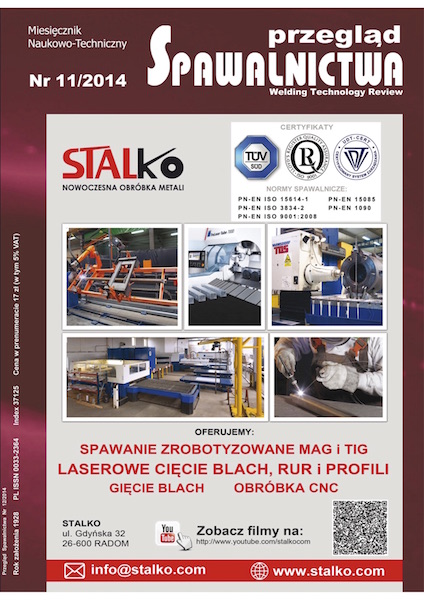The effect of selected welding parameters on properties of FSW welded joints in ferritic steel type s235 JRC+N; Wpływ wybranych parametrów zgrzewania tarciowego z przemieszaniem na właściwości złączy stali S235JRC+N
Main Article Content
Abstract
Abstract
This work presents the results of welding ferritic steel type S235 JRC, 5 mm in thickness, welded by friction stir welding (FSw) process. The aim of study was to demonstrate the effect of selected welding parameters as tool material (tungsten carbide-WC, or silicon nitride Si3N4), welding speed, tool rotation speed on the properties of welded joints and the life of welding tools. The properties of welded joints were assessed visually, by radiography RT inspection, mechanical tests and by observations of macro- and micro-structure. The life of welding tools was expressed by mass losses and also by the change in shoulder diameter and change in pin length in dependence on weld length. welding with WC tools was shown as unstable regarding the low dimen- sional stability of welding tool. On contrary, welding with ceramic tools permits formation of sound welds fabricated within optimum welding parameters with rotation speed 500 RPM and welding speed 50 to 100 mm/min. The best life of ceramic tools is achieved at rotation 400 RPM and welding speed 50 mm/min. However, at application of these parameters 100% soundness of welds over entire weld length was not achieved.
Streszczenie
w artykule zaprezentowano wyniki zgrzewania (FSW) stali S235 JRC+n o grubości 5 mm. Celem opisanego ekperymentu eksperymentu było określenie wpływu wybranych zasadniczych parametrów procesu: materiał narzędzia (WC i Si3N4), prędkość zgrzewania oraz prędkość obrotowa narzędzia, na właściwości otrzymywanych złączy oraz na trwałość narzędzia zgrzewającego. Złącza badano metodami nieniszczącymi wizualnie i z użyciem radiografii oraz metodami niszczącymi w celu określenia właściwości mechanicznych i scharakteryzowania mikro i makrostruktury. Trwałość narzędzia (trzpienia zgrzewającego) określano poprzez pomiar ubytku jego masy i charakterystycznych właściwości geometrycznych (promień i długość trzpienia). narzędzie wykonane z WC wykazało niską trwałość i stabilność wymiarową. narzędzie z ceramiki Si3N4 umożliwia uzyskiwanie dobrych zgrzein z blisko optymalną prędkością 500 obr/min. i prędkością zgrzewania 50 do 100 mm.min. Przy czym, największą trwałość narzędzia uzyskano dla prędkości 400 obr/min. i prędkości zgrzewania 55 mm/min. Jednak wtedy nie uzyskano w 100% prawidłowego połączenia.
Downloads
Article Details
Creative Commons CC BY 4.0 https://creativecommons.org/licenses/by/4.0/
Welding Technology Review (WTR) articles are published open access under a CC BY licence (Creative Commons Attribution 4.0 International licence). The CC BY licence is the most open licence available and considered the industry 'gold standard' for open access; it is also preferred by many funders. This licence allows readers to copy and redistribute the material in any medium or format, and to alter, transform, or build upon the material, including for commercial use, providing the original author is credited.
References
Rai, R. et al.: Review: friction stir welding tools, Science and Technology of welding and Joining, vol. 16, no. 4, 2011.
Thomas, W. M. Threadgill, P. L. Nicholas, E. D.: Feasibility of friction stir welding steel, Science na technology of welding and joining, Vol. 4, no. 6, 1999, s. 1362-1718.
Nandan, R., et al.: Recent advances in friction-stir welding Process weldment structure and properties, Progress in Materials Science 53, 2008, s. 980-1023.
Nelson, T. w.: Friction stir welding of ferrous alloys: current status, Material Science Forum, 2010, s. 638-642.
Prado, R. A. a kol.: Self-optimization in tool wear for frictionstir welding of Al 6061 + 20% Al2O3 MMC, Materials Science and Engineering A349, 2003, s. 156-165.
Fernandez, G. J. a kol.: Characterization of tool wear and weld optimization in the friction-stir welding of cast aluminum 359+20% SiC metal-matrix composite.
Kumar, K. et al.: The role of friction stir welding tool on material flow and weld formation, Materials Science and Engineering A485, 2008, s. 367-374.
Hua-Bin Chen et al.: The investigation of typical welding defects for 5456 aluminum alloy friction stir welds, Materials Science and Engineering A433, 2006, s. 64-69.
